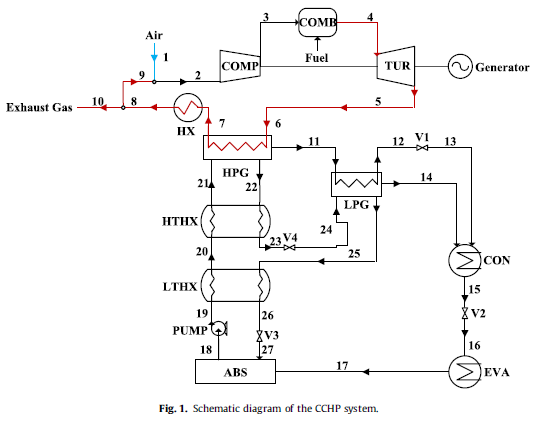The off-design performance of a combined cooling heating and power (CCHP) system is of great importance and is affected by the system configuration and operating strategy. This paper proposes an alternative operating strategy called flue gas reinjecting (FGR) for a CCHP system consisting of a small-scale gas turbine, a double-effect absorption chiller and a hot water exchanger. The FGR operating strategy elevates the compressor inlet temperature by reinjecting a portion of the flue gas into the ambient air, which seems to contradict the well-proven concept of gas turbine inlet air cooling. In contrast, improving inlet air temperature cannot obviously influence the off-design performance of the gas turbine, and more high temperature flue gas is produced in the gas turbine, which leads to more cooling and heating output in the absorption chiller and hot water exchanger, respectively. To extend the power output range (100–20%), reducing the turbine inlet temperature (TIT) operating strategy is introduced as an auxiliary means. The off-design performance of the CCHP system is investigated under the combined FGR and TIT operating strategy and independent TIT operating strategy. It is found that improved total efficiency and energy saving performance of the CCHP system are presented with the combined operating strategy at partial load. At a load rate of 50% (876 kW), the fuel energy saving ratio (FESR) increases from 20.52% to 22.96% as the temperature of the inlet air is increased from 25 to 45 °C using the combined operation strategy. The exhaust gas reinjection reduces the excess air resulting in inhibition of the formation of NOX in the combustor. Moreover, using the proposed operating strategy contributes to promoting more effective utilization of low-temperature heat and the direct blending of two fluids reduce heat and pressure losses emanating from the heat exchanger. This study may provide a new operating strategy for small-scale gas turbines to improve the off-design performance of CCHP systems.
This paper proposes and analyzes an alternative operating strategy known as flue gas reinjecting (FGR) for a combined cooling heating and power (CCHP) system. As opposed to the well proven concept of gas turbine inlet air cooling, the FGR operating strategy increases the compressor inlet temperature by reinjecting a portion of flue gas into the ambient air. To extend the power output range from 100% to 20%, reducing the turbine inlet temperature (TIT) is introduced as an auxiliary means. The off-design performance has been investigated for the CCHP system with off design models and the focus is placed on the influence of both the combined FGR and TIT operating strategy and independent TIT operating strategy. The main conclusions of this study are summarized as follows:
(1) There is no significant effect on the efficiency of the gas turbine with the combined operating strategy under part-load conditions.
(2) The combined operating strategy results in a higher exhaust gas temperature of the gas turbine; therefore, more heat contained in the flue gas is utilized in the absorption chiller despite the decrease in the mass flow.
(3) With the same gas turbine output power, the fuel energy saving ratio (FESR) and the over energy efficiency of the CCHP system are improved by the combined operation strategy. At a power load of 50% (876 kW), the CCHP system under combined operating strategy can consume 22.96% less nature gas compared with the stand-alone system, which is increased by approximately 2.44 points than under the independent TIT operating strategy.
(4) The FGR operating strategy also provides alleviation of environmental issues related to the CCHP system. One key advantage of the FGR operating strategy is that the existence of exhaust gas in the air flow decreases the excess air resulting in lower NOx emissions.
In addition, the question of whether the FGR operating strategy is an appropriate operating strategy for other gas turbines aside from OPRA OP16 will be investigated in a subsequent study.
